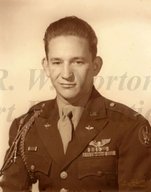
|

|
|
|
|
Norman was born in Shreveport as the son of Philip Frederick Kihneman and Gladys Colvin Kihneman. He graduated from Fair Park High School in 1941. As a teenager he sold newspapers on the corner of Milam and Louisiana and held a paper route. "We were born, I guess, in the lap of luxury," he says of his childhood. "We had lights, water, gas, indoor plumbing and so forth." Norman worked at Southern Optical as a lens grinder after high school, making $40 a week. He enlisted on November 5, 1942 as an "Air Corps enlisted reservist private," and reported for active duty in January of 1943. He was sent to Shepherd Field in Wichita Falls, Texas, for basic training. "Every morning Oklahoma would fly in," he says. "Dust was so thick that you couldn't see two people in front of you, and then every evening Texas would fly north." Norman, who had four years of ROTC training, was soon named as a drill instructor. He was soon sent to Oklahoma A&M at Stillwater for College Training Department. There he became cadet officer and squadron commander. At Aviation Cadet Center in San Antonio he qualified for pilot training. He went to flight schools in Pine Bluff, Arkansas, Independence, Kansas, and McAllen, Texas, where he earned his wings on in March of 1944. He went on to North Carolina to Seymour Johnson Air Force Base in Goldsboro, a P-47 transition base, and to Wilmington Field in Wilmington for gunnery school. He shipped overseas in August of 1944 on HMS Aquatania. He entered the Forty-eighth Fighter Group, 492nd Fighter Squadron, Ninth Air Force. The tactical unit served as close air support for front line troops. He was given a sector and told to "hit anything that moved in. He it." Along with hitting assigned targets, Norman also flew reconnaissance missions. His squadron call sign was "horse fly." Watching the ground below, Norman knew when he was flying over Allied or enemy lines. "You'd look down and see a bunch of white faces. Those were English or American. They'd watch you," he says. "When you didn't see any white faces, that was the line. The Germans didn't look up." He witnessed fatigue among fellow pilots, and could see the fear for their lives. "When they start counting their missions and wondering when they're going to have enough, they'd had enough," he says. Fatigue sent him to the hospital in early 1945. "I was just worn out," he says, recalling one stretch of flying eight missions in three days. Leaving the hospital he volunteered to ride in the lead tank of the Seventeenth Tank Battalion, Seventh Armored Division, and called in air strikes for two weeks Norman flew seventy-seven missions. "I got shot up, but I never got shot down," he recalls. Norman earned a Distinguished Flying Cross for leading an attack on marshaling fields, and for attacking an airfield and destroying an airplane. He came home on a Navy transport ship "around September of 1945." Norman accepted a reserve commission and came off active duty. He earned a degree at Monroe College of Optometry in Chicago and worked for Southern Optical. He married Mildred Watson May 16, 1946. They had two children. Norman later operated a car dealership, worked as a real estate broker, then ran a flea market for several years. |


